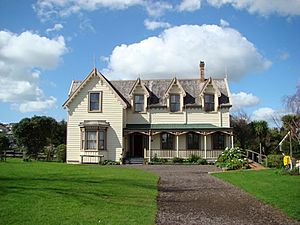Howick Historical Village facts for kids

Puhi Nui Homestead in Howick Historical Village
|
|
| Established | 8 March 1980 |
|---|---|
| Location | Pakuranga, Auckland, New Zealand |
The Howick Historical Village is a special place in Auckland, New Zealand, where you can step back in time! It's like a living museum, which means it shows you what life was like long ago. The village is made up of real old buildings from the area, put together to look like a New Zealand village from the past. Even though it's called 'Howick', it's actually located in a nearby area called Pakuranga.
Contents
Exploring the Village's Past
The village first opened its doors as the Howick Colonial Village. It was created by the Howick Historical Society. The land for the village was kindly given by the Manukau City Council.
How the Village is Supported
The village gets money to run from different places. This includes fees people pay to visit, money from special events, and donations. They also get some help from the Howick Local Board.
What You Can See at the Village
The village has many interesting old buildings. You can see cottages where soldiers called fencibles used to live. There's also an old mission house, a court house, and a traditional shop.
Filming at the Village
Since 2016, the village has been used as a place to film videos. A popular YouTube group called Viva La Dirt League uses the village as a set for their shows.
Village Challenges in 2020
In May 2020, the village faced some tough times. Like many places, it had money problems because of the COVID-19 pandemic. They had to reduce staff and looked for help from the Auckland Council and other groups.
Who Runs the Village?
The Howick Historical Village is owned and managed by a group called the Howick & Districts Historical Society Incorporated. This group is a registered charity.
Becoming a Member
Anyone can become a member of the society by paying a yearly fee. Members get to choose a board each year at a special meeting. This board helps run the village and includes a president, a secretary, a treasurer, and up to seven other members.
Visiting the Howick Historical Village
The village is open almost every day of the year. You can visit from 10 AM to 4 PM, with the last entry at 3 PM. It's only closed on Christmas Day, New Year's Day, and Good Friday.
Live Days and School Trips
On certain days, called 'Live Days', volunteers dress up in old costumes. They show what daily life was like in New Zealand during Victorian times. School groups also visit often as part of their learning outside the classroom.
Special Events at the Village
The village is a popular spot for weddings and other private parties. People often use the old church for ceremonies. The historic Bell House is also used for celebrations. The village is also a great place for filming movies or TV shows.
Bringing Old Buildings Back to Life
Over the years, many buildings in the village have been carefully repaired and restored. These buildings are made of wood and need a lot of ongoing work to keep them safe and sound.
Restoring Sergeant Ford's Cottage
In 2016, a big project started to fix Sergeant Ford's Fencible cottage. This work began with help from the New Zealand Lottery Grants Board. During the project, they found more damage to the building's base. This made the repairs cost more money, about $30,000 extra. This caused some financial difficulties for the village. Luckily, with support from the Stevenson Village Trust, the project was completed.
Fixing the Pakuranga School House
In 2019, the large Pakuranga school house was also restored. This project was funded by the lotteries commission. A team of workers and volunteers did a lot of important work. They fixed the windows and the outside walls to make sure the building was protected from the weather.

